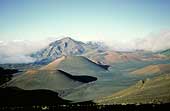|
COMETS EARTH JUPITER KUIPER BELT MARS MERCURY METEORITES NEPTUNE OORT CLOUD PLUTO SATURN SOLAR SYSTEM SPACE SUN URANUS VENUS ORDER PRINTS
PHOTO CATEGORIES SCIENCEVIEWS AMERICAN INDIAN AMPHIBIANS BIRDS BUGS FINE ART FOSSILS THE ISLANDS HISTORICAL PHOTOS MAMMALS OTHER PARKS PLANTS RELIGIOUS REPTILES SCIENCEVIEWS PRINTS
|
Related Document
Download Options
This picture was taken looking east across Haleakala Crater in East Maui. Young cinder cones can be seen in foreground. The Haleakala Crater is a large topographic depression that occupies the summit region of East Maui volcano. The crater is breached at its northwest and southeast corners by large valleys that drain to the north and south coasts, respectively. The crater originated by erosion, according to most published accounts. When asked about Hawaiian volcanoes, most people imagine the Big Island and its eruptions at Kilauea or Mauna Loa volcanoes. But East Maui volcano has witnessed eruptions as recently as about 1790 A.D., and numerous eruptions have occurred there in the past 10,000 years. Thus the volcano's long eruptive history and recent activity indicate that East Maui volcano will erupt in the future. Haleakala National Park is the most visited part of East Maui. The Hawaiian name Hale-a-ka-la (lit., house of the sun), is now nearly synonymous with the entire shield of East Maui volcano. Early Hawaiians, however, applied the name only to the summit area, the site where the demigod Maui snared the sun and forced it to slow its journey across the sky. The oldest lava exposed on East Maui is about 1.1 million years in age. It is part of a sequence of flows emplaced near the end of shield building on East Maui. The time estimated to build a volcano from ocean floor to the end of its shield-building stage is about 0.6 million years. Thus, East Maui volcano probably began its growth between about 1.5 and 2.0 million years ago. Volcanism of the past 30,000 years on East Maui has been focused along the southwest and east rift zones. These two volcanic axes together form one gently curving arc that passes from La Perouse Bay (southwest flank of East Maui) through Haleakala Crater to Hana on the east flank. The alignment continues east beneath the ocean as Haleakala Ridge, one of the most sizable rift zones along the Hawaiian Islands volcanic chain. The on-land segment of this lengthy volcanic line of vents is the zone of greatest hazard for future lava flows and cindery ash. |
